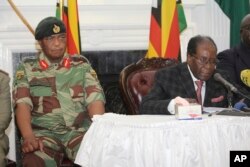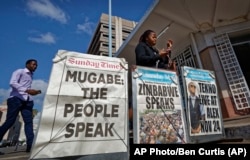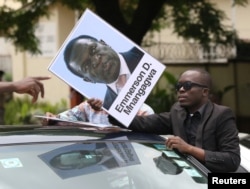Zimbabwe’s ruling Zanu-PF party announced Monday that it has started the impeachment process against President Robert Mugabe, following his failure to resign by a 12pm deadline, after the party recalled him as party chief.
Party spokesman and Information Minister Simon Khaya Moyo told reporters that President Mugabe had been formally notified of their decision, and that of the 260 members present, 230 voted to impeach him.
“The party has instructed the chief whip to proceed with impeachment processes against Comrade R.G. Mugabe as it has not received the anticipated confirmation of his resignation from the Speaker of Parliament,” said Moyo.
Mugabe baffled the nation Sunday night when he did not resign as expected during his speech on the state-run Zimbabwe Broadcasting Corporation. The military had spent the days since they grabbed control of the government last week trying to persuade him to resign.
Now, Members of Parliament say the way is clear. "I don't see us failing to proceed with the impeachment and we have the numbers,” says Lovemore Matuke, the ZANU-PF chief whip.
According to the Zimbabwe constitutional watchdog, Veritas, it is possible to impeach Mugabe but some legal experts say it is a difficult process.
Constitutional law expert and University of Zimbabwe law professor Lovemore Madhuku says impeachment means charging an office holder with misconduct and removing him from office if he is found guilty.
“The law of impeachment starts from the position that you have to accuse the president of either misconduct or incapacitation,” Madhuku says.
“An impeachment is different from a vote of no confidence. With a vote of no confidence you simply say we have no confidence with you and vote to get the person out of office. But with impeachment you have to lay out charges.”
The Veritas group, however, says “The first thing to remember is that it is essentially a political process rather than a legal one.”
That means the decision to impeach a president and remove him or her from office, is made on political rather than legal grounds.
Three Stage Process
Innocent Gonese, a lawyer and the opposition MDC parliamentary chief whip, says under Section 97 of the Constitution impeachment is a three-stage process.
First, the Senate and National Assembly must hold a joint sitting, and by simple majority vote decide if the president should be removed. There are four possible grounds for removal: serious misconduct, failure to obey, uphold or defend the Constitution, willful violation of the Constitution and inability to perform his duties because of physical or mental incapacity.
The next step, Gonese says, after a resolution has been passed, is for the Committee on Standing Rules and Orders to appoint a nine-member committee of senators and members of the National Assembly to investigate the reasons for removing the president. The committee would likely allow the president to respond to the allegations, as the Constitution grants the right to a fair hearing.
If the committee recommends removing the president, the Senate and National Assembly must meet to deliberate the recommendation. Gonese says that if two-thirds of the members vote to adopt the recommendation “then the president immediately ceases to hold office.”
But it’s not clear how long it will take. The Parliament’s procedural orders don’t say how much notice must be given for sessions regarding impeachment motions,” Gonese says. In fact, they don’t deal with impeachment at all.
Legal experts say without a laid-down procedure, it appears the members and the staff of parliament will make it up as they go along.
Watchdog group Veritas says the process will need at least several days to complete, since all there must be a day’s notice before any motion is debated. And it takes time to schedule the joint sessions and name the investigative committee.
Result of Impeachment
According to the constitution, if President Mugabe is impeached, a vice-president takes over as acting president. Mugabe had two vice presidents, but at the moment there is only one, Phelekezela Mphoko. Mugabe fired Emmerson Mnangagwa earlier this month, starting this crisis.
However, on Sunday, ZANU-PF resolved to remove Mphoko from his the position as vice president, and as second secretary of the party.
But Professor Lovemore Madhuku says the party action doesn’t affect his position as vice president.
What’s more, legal experts note, if Mphoko resigns or is otherwise ousted, then there is no vice president, and only a president can appoint a new vice president. That would complicate any efforts to install Emmerson Mnangagwa as president, as many Zimbabweans expect.
The Veritas group also notes if there is no vice president, then the cabinet members need to appoint one of themselves as acting president. The acting president then could appoint a vice president.
But University of Kent law constitutional expert, Alex Magaisa, says once Mugabe is impeached, it is easy to deal with Mphoko. “Those pushing for Mnangagwa if they want, they can quickly replace Mugabe the very moment he is declared that he is no longer president. They can submit Mnangagwa as the person they have nominated and say in accordance with the constitution, this is the person we have nominated.”
No matter how the issue of the vice president is dealt with, there is no easy path to impeachment.
Professor Madhuku says the process of impeaching the president is designed to fail. “The impeachment process is a very long process. It is not a one day or two day process, it can go for months and can also involve the courts if the person you are impeaching wants to take advantage of a number of rights that are in the constitution. It is a process in our constitution that was designed never to work,” he says.
The simplest options, experts say, would be for Mugabe to retire, and appoint a new vice president before doing so.







